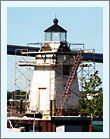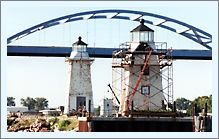|
Historical
Information

Situated in a heavily forested area far to the north of the
burgeoning development in the mid continent, the settlement at the mouth
of the Fox River which would eventually become known as Green Bay, grew
more slowly than rival lumber ports due to its location at the southern
end of the bay, and the hazardous trip vessels were forced to take
through the infamous Porte Des Morts passage before heading south toward
the Fox River. Further complicating entry into the river itself was a
thin sliver of land known as Grassy Island, which spread a mile offshore
at the foot of the bay, forcing mariners to circumnavigate the island to
gain entry into the river.
The areas bounty and commercial potential was evident as early as
July 7, 1838, when at the urging of local maritime interests, Congress
appropriated $4,000 for the establishment of a lighthouse on Grassy
Island, to warn mariners of the island during while seeking river entry.
In 1838, Lieutenant James T Homans, to whom responsibility for the
lighthouses of the Northern Great Lakes fell at the time, sailed up the
lakes to locate appropriate sites for a number of new lighthouses for
which appropriations had been authorized the previous year. Arriving at
Grassy Island, Homans was dismayed with what he found, reporting the
island to be "unsuitable for construction of buildings upon it of
any durability, and totally uninhabitable by a keeper, being nearly
under water, from the great rise of the lake, since the recommendation
for a light upon it was made." Searching for an alternate location
for the Light, Homans recommended that the light instead be established
on Tail Point, a peninsula lying a short distance north of Grassy
Island, with both higher and ground and blessed by the local mariners
with whom he spoke during his visit.
Fox River business interests were not easily dissuaded, and continued
to apply pressure for the establishment of a lighthouse on Grassy
Island. After the Legislature of the Territory of Wisconsin passed a
resolution in favor of establishing a light on Grassy Island, the
Governor of the Wisconsin Territory even convinced Vice President
Mifflin Douglas and Speaker John Wesley Davis to go before the Senate
and House respectively on February 1, 1846 to plead their case. While
the matter was referred to the Commerce Committee, and a bill
subsequently passed approving the establishment of the station on July
2, 1846, no appropriation was made. Thus the Lighthouse Board moved
ahead with construction of the Tail Point light station, and it appeared
that the matter of a light on Grassy Island was dead.
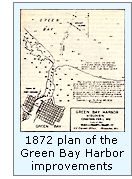 Gaining in creasing importance as both a lumber port and as an
immigrant-outfitting center for northeast Wisconsin, by the mid 1850's
the Fox River area boasted thirty-five sawmills. While the panic of 1857
slowed development considerably, good times returned in the early
1860's, with the sawmills once again operating at full steam. With
increasingly large vessels seeking entry into the river, the Army Corps
of Engineers was dispatched to Green Bay to formulate a plan to open the
harbor to vessels of greater draft, and with the passage of the River
and Harbor Act of June 23, 1866, $30,000 was appropriated to cut and
dredge an improved channel into the river. Work began in 1867 under the
direction of Major Junius B Wheeler, and a channel 200 feet wide by 13
feet deep was dredged from the mouth of the Fox River straight through
the middle of Grassy Island and out into the Bay to the natural 13-foot
depth. Gaining in creasing importance as both a lumber port and as an
immigrant-outfitting center for northeast Wisconsin, by the mid 1850's
the Fox River area boasted thirty-five sawmills. While the panic of 1857
slowed development considerably, good times returned in the early
1860's, with the sawmills once again operating at full steam. With
increasingly large vessels seeking entry into the river, the Army Corps
of Engineers was dispatched to Green Bay to formulate a plan to open the
harbor to vessels of greater draft, and with the passage of the River
and Harbor Act of June 23, 1866, $30,000 was appropriated to cut and
dredge an improved channel into the river. Work began in 1867 under the
direction of Major Junius B Wheeler, and a channel 200 feet wide by 13
feet deep was dredged from the mouth of the Fox River straight through
the middle of Grassy Island and out into the Bay to the natural 13-foot
depth.
As work progressed, the Lighthouse Board recommended the
establishment of a lighthouse to guide vessels to the new cut through
Grassy Island, and Congress responded with an appropriation of $11,000
for the new station on April 7, 1866. However, with the harbor
improvements still far from completion, the decision was made to
postpone the establishment of the new light until the completion of the
harbor improvements. With work close to completion in 1871, Eleventh
District Engineer Brevet Brigadier General O. M. Poe approved plans and
specifications for the erection of a pair of range lights on the island,
and materials for their construction were ordered that winter.
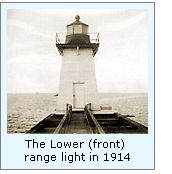 After the delivery of a work crew and supplies on the island, work
began in the spring of 1872, and progressed through the remainder of the
year. Standing on a timber pier on the east side of the cut, a pair of
timber framed shingled beacon lights were erected 676 feet apart. Thee
25-fot tall lower light at the northern end of the pier was topped with
an octagonal cast iron lantern, and equipped with fixed white Sixth
Order Fresnel lens. With a focal plane of 30 feet, its light was visible
for a distance 11 miles in clear weather. The Upper Light stood ten feet
taller, and outfitted with a lens of similar order and characteristic,
was visible for a distance of 13 miles. A two story keepers dwelling was
erected approximately 100 feet to the north of the Upper Light, and with
the construction of a boathouse, privy and woodshed, construction of the
station was completed in October, and Joseph B. Wing appointed as the
stationís first keeper. While Wing is first listed at the station on
October 12, he did not officially exhibited the lights until the night
of November 15, 1872. After the delivery of a work crew and supplies on the island, work
began in the spring of 1872, and progressed through the remainder of the
year. Standing on a timber pier on the east side of the cut, a pair of
timber framed shingled beacon lights were erected 676 feet apart. Thee
25-fot tall lower light at the northern end of the pier was topped with
an octagonal cast iron lantern, and equipped with fixed white Sixth
Order Fresnel lens. With a focal plane of 30 feet, its light was visible
for a distance 11 miles in clear weather. The Upper Light stood ten feet
taller, and outfitted with a lens of similar order and characteristic,
was visible for a distance of 13 miles. A two story keepers dwelling was
erected approximately 100 feet to the north of the Upper Light, and with
the construction of a boathouse, privy and woodshed, construction of the
station was completed in October, and Joseph B. Wing appointed as the
stationís first keeper. While Wing is first listed at the station on
October 12, he did not officially exhibited the lights until the night
of November 15, 1872.
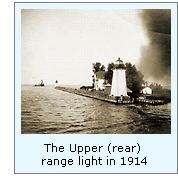 As a result of their exposed location, by 1880 the roofs of the
dwelling and woodshed had deteriorated to a point that they needed
complete replacement, and with a crew on the island, the dwelling was
also completely repainted inside and out. 1889 saw the erection of a
breakwater to stem erosion on the east side of the island, and a 10 foot
by 16 foot landing dock was erected beside the boathouse. As a result of their exposed location, by 1880 the roofs of the
dwelling and woodshed had deteriorated to a point that they needed
complete replacement, and with a crew on the island, the dwelling was
also completely repainted inside and out. 1889 saw the erection of a
breakwater to stem erosion on the east side of the island, and a 10 foot
by 16 foot landing dock was erected beside the boathouse.
Keeper Wing passed away on October 24, 1895 after 23 years of
faithfully keeping the Grassy Island Range. To replace Wing, Ole Hansen
accepted a transfer from Ahnapee, where he had been serving as keeper of
the past two years. The year after Hansen arrived, a work crew arrived
at the island, and demolished and rebuilt both the kitchen addition and
the boathouse, which were showing signs of damage as a result of
frequent standing water around the station.
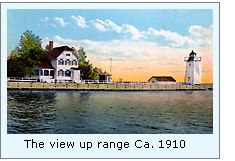 The steamer ALICE M GILL, which was under lease to the Ninth District
while two new tenders were being built, arrived on the island in 1901
with a work party and materials for major repairs at Grassy Island.
After both Upper and Lower lights were re-shingled and painted, a brick
oil storage building was erected between the dwelling and the Upper
light. 40 yards of stone were also placed to the east of the station to
serve as a protection against rising water levels. 1901 also saw the
addition of a First Assistant Keeper at the station, with Guy E Leach
appointed to the position on September 5, 1901. With lake levels
continuing to rise, in 1902 the boathouse was raised and placed atop 17
posts driven into the ground, and a 44-foot long trestle walk was laid
from the boathouse to the landing crib. The 65-foot long walkway from
the revetment at the south side of the dwelling leading to the boathouse
was also raised on posts. The steamer ALICE M GILL, which was under lease to the Ninth District
while two new tenders were being built, arrived on the island in 1901
with a work party and materials for major repairs at Grassy Island.
After both Upper and Lower lights were re-shingled and painted, a brick
oil storage building was erected between the dwelling and the Upper
light. 40 yards of stone were also placed to the east of the station to
serve as a protection against rising water levels. 1901 also saw the
addition of a First Assistant Keeper at the station, with Guy E Leach
appointed to the position on September 5, 1901. With lake levels
continuing to rise, in 1902 the boathouse was raised and placed atop 17
posts driven into the ground, and a 44-foot long trestle walk was laid
from the boathouse to the landing crib. The 65-foot long walkway from
the revetment at the south side of the dwelling leading to the boathouse
was also raised on posts.
After seven years at Grassy Island, Ole Hansen arranged a
"station swap" with Louis Hutzler, the keeper at Tail Point,
and on December 31 the two keepers traded positions. We have come across
a number of examples of such "station swaps" in our research,
and thus it would appear that the Lighthouse Board showed a willingness
to accommodate the needs of keepers when such solutions were mutually
beneficial to all parties.
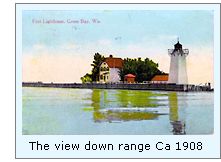 On May 15, 1907, a pile driver was towed out to the island to drive
250 feet of pile and corrugated sheet metal revetments to the east of
the dwelling to further stave rising lake levels, and with its
foundation still frequently in standing water, the dwelling was also
resided and painted. On May 15, 1907, a pile driver was towed out to the island to drive
250 feet of pile and corrugated sheet metal revetments to the east of
the dwelling to further stave rising lake levels, and with its
foundation still frequently in standing water, the dwelling was also
resided and painted.
As a result of positive experiences with acetylene lighting systems
throughout the Great Lakes, acetylene lights with automatic sun valves
were installed in both ranges in 1834. With this change, the
characteristic of both lights were also changed, with the Upper light
changed to fixed green with a visibility range of 10 miles, and the
Lower light to a single green flash every 5 seconds. With the sun valve
automatically turning the lights on at dusk and off at sunrise, the full
time attention of a keeper was no longer necessary, and at 66 years of
age, Louis Hutzler retired from lighthouse service, thus serving as the
last keeper of the Grassy Island Range.
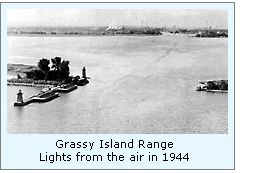 Dredging in the harbor continued on an almost annual basis throughout
the years, and the original channel through the island was successively
widened on numerous occasions, with each widening operation being
performed on the west of the channel opposite the range lights. With the
universal adoption of radar and LORAN, the range lights had long since
outlived their purpose as navigational aids, and in 1966 the decision
was made to destroy the lights in place, and to widen the channel
through what was left of the east side of Grassy Island. Dredging in the harbor continued on an almost annual basis throughout
the years, and the original channel through the island was successively
widened on numerous occasions, with each widening operation being
performed on the west of the channel opposite the range lights. With the
universal adoption of radar and LORAN, the range lights had long since
outlived their purpose as navigational aids, and in 1966 the decision
was made to destroy the lights in place, and to widen the channel
through what was left of the east side of Grassy Island.
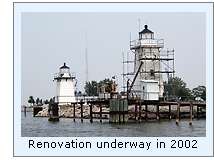 Hearing of the Coast Guardís plans for the historic beacons, Green
Bay Yacht Club member "Admiral" Merlin J Baenen and a number
of associates managed to arrange for the lights to be relocated to the
Yacht Club property on the east side of the Fox River. With the Coast
Guard's assistance, the lights were carefully removed from the island
and placed in the yacht club parking lot until their final home cold be
decided. Hearing of the Coast Guardís plans for the historic beacons, Green
Bay Yacht Club member "Admiral" Merlin J Baenen and a number
of associates managed to arrange for the lights to be relocated to the
Yacht Club property on the east side of the Fox River. With the Coast
Guard's assistance, the lights were carefully removed from the island
and placed in the yacht club parking lot until their final home cold be
decided.
In 1999, the two towers were relocated onto piers at either side of
the yacht club entrance, and Baenen and his team began the task of
restoring the lights. Restoration work continued throughout the
following six years, with the completely restored lights dedicated at a
public ceremony on November 5, 2005.

Keepers of this Light

Click Here to see a complete listing of
all Grassy Island Range Lights keepers compiled by Phyllis L. Tag of
Great Lakes Lighthouse Research.

Seeing these lights

In Green Bay, take I-43 west to Webster Avenue. Turn right at the first
stop sign, and then left on Bay Beach Road. Follow Bay Beach Road to
it's end at the Fox River, and turn left into the Municipal boat launch
parking lot. The lights will be seen a few hundred feet upriver,
immediately north of the Coast Guard Station.

Reference
Sources

Congressional records,
various, 1836 - 1866
Annual reports of the Fifth Auditor of the Treasury, 1838
Lighthouse Board annual reports, 1868 - 1906
Great Lakes Light Lists, various, 1876 - 1909
Those Army Engineers, Chicago District, John W. Larson, 1979
Personal observation and photography in Green Bay, 09/13/2000.
Undated Green Bay News Chronicle article in Green Bay Public Library
vertical file.
Keeper listings for this
light appear courtesy of Great
Lakes Lighthouse Research
|
